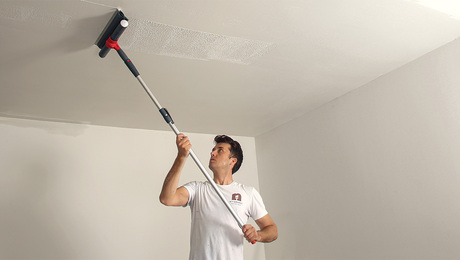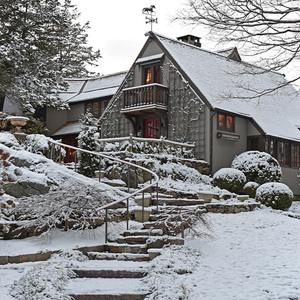*
I don’t think it’s a grounding problem- the ground doesn’t usually carry current (at least, current’s not supposed to be there). I do suspect loose connections or degraded/broken wires- something aluminum wires are famous for. Even if you have copper wires, they can develop cracks wherever they are subject to flexing. Connections can corrode as well (especially outside). Loose wire nuts are also a common cause of problems such as yours. That your problem continued on a second circuit suggests that the two circuits share a neutral, and that the problem is in the neutral. (By the way, are all of your plugs ‘polarised?’) Tracking this down- something I reccomend, as you have a little problem looking for a chance to grow bigger-in a systematic way is for someone with professional training. If nothing else, a pro will be able to spot any “hillbilly” engineering performed by the previous owner!
Discussion Forum
Discussion Forum
Up Next
Video Shorts
Featured Story

Skim-coating with joint compound covers texture, renews old drywall and plaster, and leaves smooth surfaces ready to paint.
Featured Video
Builder’s Advocate: An Interview With ViewrailHighlights
"I have learned so much thanks to the searchable articles on the FHB website. I can confidently say that I expect to be a life-long subscriber." - M.K.














Replies
*
TAB,
Nice troubleshooting work.
There may well be a loose neutral in the circuit. This is a common cause of lights flickering on an entire circuit or on several circuits.
The neutral may be loose at the panel (which is your responsibility), or at the meter socket, the service drop, or the pole-top (or pad-mounted) transformer (any of these is the electric utility's responsibility). Ask your neighbors if they're experiencing the same sort of thing; if so, there's a good chance it's a loose neutral on the power co. side.
A loose neutral is a safety hazard. Any 120 V branch circuit with a shared neutral (common in kitchens) will see up to 240 V if you lose the utility neutral.
Another possible cause for the flickering is a power user in your area who has a big intermittent load, causing voltage sags. Any light industry or commercial in the area? Any neighbor with 2 large AC units? Does the flickering occur just at certain times?
My suggestion: call the utility. Talk to a repair crew dispatcher or foreman. Discribe the symptoms and ask if they could check their side for a loose neutral. Usually they are ringing your doorbell as you hang up your phone! But really, they usually do handle such a situation as a high priority--which gives you an idea of how serious it may be.
If the power co. gives their wires a clean bill of health, then it's time to call an electrician. Preferably one who has power quality instruments (at least a timestamp voltmeter).
God luck!
*
Funny you should mention. My mom's house - plumber installing new steam heat boiler. Shuts off supply, drains old boiler, cuts old pipe with sawzall. Gets shock of a lifetime, luckily only permanent damage is a fried sawzall. Calls electrician buddy, and he finds a 5 A current in the pipe - ground current from service panel. Investigates further, finds loose neutral - on the pole. Electric company temporarily 'fixes' it, promises to come out and rewire. Problem still there almost a year later.
*Hi all:Thanks for the suggestions - but, get the latest:The brand new fixture I got had a pullchain installed (I didn't want to go to the trouble of busting into the wall to install a switch... ha ha ha...).I took the pullchain leg out of the fixture and wired the fixture back into the circuit. No flickering.Crying, however, may have been observed by the keen onlooker...Here's the gist of it. The initial outlet was shot - poor internal connections (or wires) made for a flickering light. The new light came stock with the same problem, either a defective pullchain mechanism itself or poor connections. Success is a bittersweet fruit.-t
*Thanks for being one of the few to come back with a report. We all learn sumthin.
*So, did you put that wall switch in or do you just crank on the bulb when you want to turn 'er off 'n' on?
*So I guess we can rescind those kudos to Rejuvenation Hardware?
*Amy, I'm gald someone's keeping score around here! Good eye. Jeff
*
Hi:
This one is driving me crazy. A light in our house flickered and occasionally cut out entirely. This has gone on since we bought the place. Yes it made me nervous, but you know how things go... it took a while to get to it.
I pulled the fixture out, found 115-120V coming into the box and figured that the fixture was shot (old, w/fraying wire and a wonky pullchain trigger), so we bought a nice new fixture (kudos to Rejuvenation Hardware...). I installed the new fixture, but still had the same problem. I tracked the power line to an upstairs junction box. I moved the light onto a different circuit (there were two powered lines coming into the junction box). The light still flickered/cut out.
O.K. I'm now convinced that the problem must be the wire between the light and the upstairs junction box. The easiest solution (I thought...) was to grab a line off a different circuit, and run it out to the light.
There! I thought, new curcuit - new line. What happens?
The light flickers.
It's actually not nearly as bad as before, but it's still noticeable. There is a receptacle on the new circut I wired. When I plug a lamp into it, the light does NOT flicker!?
I'm starting to wonder if the breaker box/house is properly grounded, although I don't see why it would only cause a problem for one light? None of the other lights flicker, and we don't seem to burn out bulbs at too quick a rate.
Same deal goes for the breaker connections to the panel. It's tough to imagine three different breakers on a relatively new panel (installed 1990) having connection problems.
How do I go about testing the adequacy of the house ground? (We have 200 amp service) It appears that we are grounded to both the cold water pipes (4 ga. jumpers across plastic connections) and a buried 4 ga. wire outside. I haven't found any grounding stakes.
Any other ideas?
Thanks,
-t
*You don't have aluminum wiring by any chance?
*TAB, your post reads as if you are thinking "Bad ground" like a car is wired?? Power into bulb, power out of bulb, goes to ground through chassis? That upstairs junction box, how many wires total & what colors? When you say "two powered lines coming in" what exactly do you mean? Two single wires? Two Romex cables? Joe H
*I don't think it's a grounding problem- the ground doesn't usually carry current (at least, current's not supposed to be there). I do suspect loose connections or degraded/broken wires- something aluminum wires are famous for. Even if you have copper wires, they can develop cracks wherever they are subject to flexing. Connections can corrode as well (especially outside). Loose wire nuts are also a common cause of problems such as yours. That your problem continued on a second circuit suggests that the two circuits share a neutral, and that the problem is in the neutral. (By the way, are all of your plugs 'polarised?') Tracking this down- something I reccomend, as you have a little problem looking for a chance to grow bigger-in a systematic way is for someone with professional training. If nothing else, a pro will be able to spot any "hillbilly" engineering performed by the previous owner!
*TAB,Silly question: Did you take the bulb from the old fixture and place it in the new fixture?Jerry
*I think the house is haunted.
*When you ran in the new circuit: you did completely remove the original circuit, including its ground wire from the junction box - right ?